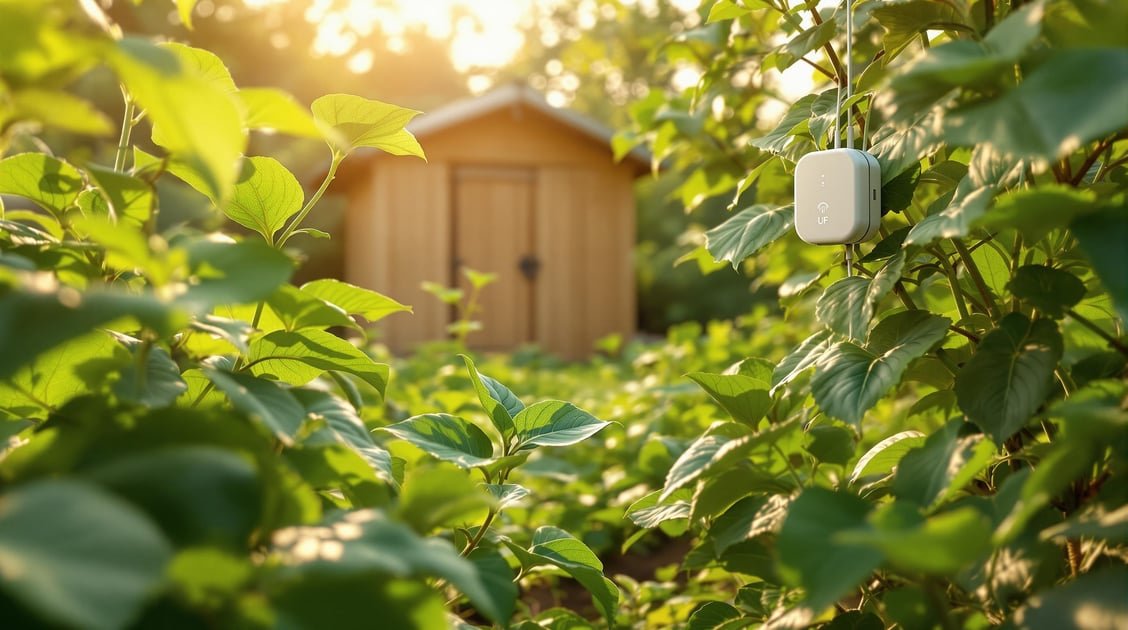IoT Security for Garden Sensors: Key Features

IoT garden sensors help monitor soil, temperature, light, and pests, but they also bring security risks. Protect your garden’s data with these steps:
- Encrypt Data: Use AES encryption and secure protocols like TLS 1.3 or DTLS to shield data during storage and transmission.
- Control Access: Implement Role-Based Access Control (RBAC) or Attribute-Based Access Control (ABAC) to manage who can access sensor data.
- Secure Your Network: Isolate sensors on a VLAN, use firewalls, and encrypt wireless connections with WPA2-PSK (AES).
Quick Tips:
- Change default passwords.
- Update firmware monthly.
- Monitor network activity for unusual behavior.
These measures ensure your garden sensors stay secure and reliable.
IoT Hacks | Episode 8 | IOT based Theft detection Alert System ...

1. Data Encryption Methods
Data encryption plays a critical role in keeping IoT garden monitoring systems secure, shielding sensor data from unauthorized access and tampering. As highlighted earlier, encryption acts as the primary defense for protecting garden sensor data. Most modern IoT garden sensors rely on symmetric encryption methods like AES (Advanced Encryption Standard) to secure data stored in their memory. Many of these sensors come equipped with hardware support for AES-128 or AES-256, enabling quick and efficient encryption of information such as soil moisture, temperature, and other sensor readings.
When it comes to transmitting data, garden sensors typically use TLS 1.3 for MQTT-based communication or DTLS for CoAP-based interactions. These protocols incorporate Elliptic Curve Diffie-Hellman (ECDH) for secure key exchanges, paired with X.509 certificates for mutual authentication. This combination ensures that data remains protected from man-in-the-middle attacks during transmission. Once encrypted, the next step is determining who has the authority to decrypt and access this information.
Up next, we'll dive into user access controls and how they manage decryption permissions.
2. User Access Controls
Encryption protects data while it's stored or being transferred, but user access controls determine who can decrypt and interact with sensor data. These controls act as an additional security layer, managing who can view or change sensor information through systems like Role-Based Access Control (RBAC) or Attribute-Based Access Control (ABAC).
- RBAC: Permissions are tied to specific roles, such as "gardener" or "technician." It's straightforward and works well for most scenarios.
- ABAC: Decisions are based on attributes like user identity, time of day, or sensor status. This allows for more flexible and dynamic control.
If you're looking for simplicity, RBAC is a solid choice. For more detailed and adaptable control, ABAC might be the better option. Up next, we’ll dive into network protection strategies that help enforce these access controls.
sbb-itb-4d6a8dd
🚀 Ready to Reinvent Your Garden?
Join thousands of homeowners who have transformed their gardens using our AI design tool. Upload one photo to explore endless possibilities.
Get your AI garden designs →3. Network Protection Setup
Once you've established user access controls, it's time to secure the network that supports your sensor data. Start by isolating and monitoring sensor traffic to keep it separate from other network activities.
One effective approach is to place sensors on a dedicated VLAN and configure a firewall designed to manage IoT traffic. Key steps include:
- Blocking incoming connections to prevent unauthorized access.
- Restricting outbound traffic to only essential services.
- Monitoring for unusual activity or anomalies.
- Logging all network traffic for analysis.
- Using WPA2-PSK (AES) encryption for wireless connections to ensure secure communication.
Security Checklist
- Change default credentials: Replace factory-set usernames and passwords immediately.
- Update firmware regularly: Aim for monthly updates to patch vulnerabilities.
- Set up activity alerts: Get notified of unusual network behavior in real-time.
- Review logs consistently: Analyze traffic logs and ensure firmware stays updated.
These measures strengthen your network's defenses while giving you better control over your IoT environment.
Benefits and Limitations
When using encryption, access controls, and network defenses for garden sensors, it's important to weigh their advantages against potential trade-offs.
- Encryption: Protects data integrity and confidentiality but increases power consumption and processing demands.
- Access Controls: Restrict access and enable tracking through audit trails, but they can create administrative challenges and risks like accidental lockouts.
- Network Segmentation and Firewalls: Enhance isolation and security but come with added configuration complexity and may introduce latency.
Consider these measures alongside the device's limitations - such as battery life and processing power - to maintain effective and dependable performance.
Summary
Protecting IoT garden sensors involves three critical layers: data encryption, user access controls, and network security measures. These layers combine to create a strong defense for smart garden monitoring systems.
Key steps to implement:
- Encrypt data both during transmission and while stored.
- Use role-based or attribute-based access controls to manage user permissions.
- Segment networks with firewalls and keep an eye on IoT traffic for unusual activity.
These measures help safeguard your smart garden from breaches and unauthorized changes.
Related posts
Related Articles

Ultimate Guide to Smart Garden Lighting Setup
Learn how to enhance your outdoor space with smart garden lighting through effective planning, installation, and automation techniques.

Garden Soil vs Topsoil: Which One to Use for Your Garden
Learn about the differences between garden soil and topsoil and find out which one is best for your garden. Discover the pros and cons of each and how to choose the right soil for your plants.

How AI Recommends Plants for Your Climate
Explore how AI simplifies gardening by analyzing climate, soil, and personal preferences to recommend thriving plants for your garden.

7 Garden Design Mistakes to Avoid When Planning Your Landscape
Avoid common garden design pitfalls with these essential tips for creating a beautiful and functional landscape year-round.

AI Garden Styles for Every Season
Transform your garden throughout the year with tailored seasonal designs and plant recommendations based on local climate conditions.

10 Minimalist Garden Ideas for Small Urban Spaces
Transform small urban spaces into tranquil retreats with minimalist garden ideas that emphasize simplicity and smart design choices.